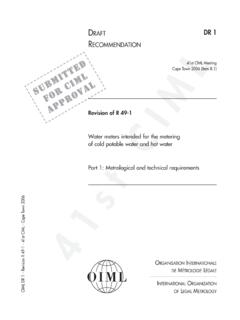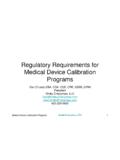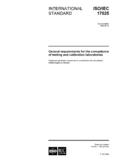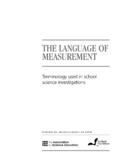Transcription of INTERNATIONAL OIML R 80-1 RECOMMENDATION …
1 Road and rail tankers with level gauging Part 1: Metrological and technical requirementsCamions et wagons citernes avec mesurage de niveau Partie 1: Exigences m trologiques et techniquesOIML R 80-1 Edition 2009 (E)OIML R 80-1 Edition 2009 (E)ORGANISATIONINTERNATIONALEDEM TROLOGIEL GALEINTERNATIONALORGANIZATIONOFLEGALMETR OLOGYINTERNATIONALRECOMMENDATION 3 Contents Foreword .. 4 1 Scope .. 5 2 Terminology .. 5 3 Classification and 14 General .. 14 Construction of tanks .. 15 4 Units of measurement .. 17 5 Technical and metrological requirements .. 17 General.
2 17 Container of the measuring tank .. 20 Additional devices .. 23 Level gauging system .. 25 Tank capacity table .. 28 Metrological requirements for indicating and ancillary devices .. 29 Additional requirements for measuring systems with electronics parts .. 32 6 Plates, documents and sealing .. 36 Identification plate .. 36 Measuring system document .. 36 Tank capacity plate on tanks with dispsticks scaled in non-volumetric units .. 37 Verification certificate .. 37 Seals.
3 38 7 Bibliography .. 40 8 Index .. 41 Annex A Example for tankers with mechanical sensors (Informative) .. 45 Annex B Example for automatic measuring systems with electronic level gauging (Informative) .. 54 Annex C Examples for volume conversion petroleum products and lubricants (Informative) .. 58 Annex D Examples for volume conversion - Liquefied petroleum gas (Informative) .. 60 Annex E Density and volume (of 1 kg) of distilled water (Informative) .. 61 4 Foreword The INTERNATIONAL Organization of Legal metrology (OIML) is a worldwide, intergovernmental organization whose primary aim is to harmonize the regulations and metrological controls applied by the national metrological services, or related organizations, of its Member States.
4 The main categories of OIML publications are: INTERNATIONAL Recommendations (OIML R), which are model regulations that establish the metrological characteristics required of certain measuring instruments and which specify methods and equipment for checking their conformity. OIML Member States shall implement these Recommendations to the greatest possible extent; INTERNATIONAL Documents (OIML D), which are informative in nature and which are intended to harmonize and improve work in the field of legal metrology ; INTERNATIONAL Guides (OIML G), which are also informative in nature and which are intended to give guidelines for the application of certain requirements to legal metrology ; and INTERNATIONAL Basic Publications (OIML B), which define the operating rules of the various OIML structures and systems.
5 OIML Draft Recommendations, Documents and Guides are developed by Technical Committees or Subcommittees which comprise representatives from the Member States. Certain INTERNATIONAL and regional institutions also participate on a consultation basis. Cooperative agreements have been established between the OIML and certain institutions, such as ISO and the IEC, with the objective of avoiding contradictory requirements. Consequently, manufacturers and users of measuring instruments, test laboratories, etc. may simultaneously apply OIML publications and those of other institutions.
6 INTERNATIONAL Recommendations, Documents, Guides and Basic Publications are published in English (E) and translated into French (F) and are subject to periodic revision. Additionally, the OIML publishes or participates in the publication of Vocabularies (OIML V) and periodically commissions legal metrology experts to write Expert Reports (OIML E). Expert Reports are intended to provide information and advice, and are written solely from the viewpoint of their author, without the involvement of a Technical Committee or Subcommittee, nor that of the CIML. Thus, they do not necessarily represent the views of the OIML.
7 This publication - reference OIML R 80-1, edition 2009 (E) - was developed by the OIML Technical Subcommittee TC 8/SC 1 Static volume and mass measurement. It was approved for final publication by the INTERNATIONAL Committee of Legal metrology in 2009 and will be submitted to the INTERNATIONAL Conference of Legal metrology in 2012 for formal sanction. This Edition supersedes the previous edition of OIML R 80 (Edition 1989). OIML Publications may be downloaded from the OIML web site in the form of PDF files. Additional information on OIML Publications may be obtained from the Organization s headquarters: Bureau INTERNATIONAL de M trologie L gale 11, rue Turgot - 75009 Paris - France Telephone: 33 (0)1 48 78 12 82 Fax: 33 (0)1 42 82 17 27 E-mail: Internet: 5 Road and rail tankers with level gauging Part 1: Metrological and technical requirements 1 SCOPE This RECOMMENDATION specifies the metrological and technical requirements applicable to static measuring systems for volume of liquids subject to legal metrological controls.
8 It also provides requirements for the approval of parts of the measuring systems. It applies to tankers for the transport of liquid products by road and rail and used, in addition to their functions as carriers, as transportable measuring tanks. Examples are given in Annexes A and B. Tankers may be considered as measuring instruments for liquids of which the viscosity does not exceed 20 at working temperature. This RECOMMENDATION is also applicable for measuring partial volume received or delivered. Essential metrological requirements of this RECOMMENDATION are in accordance with the relevant requirements of OIML R 117 Measuring systems for liquids other than water [3] referring to measuring systems with liquid meters used for the same purpose.
9 In addition to the metrological and technical requirements included in this Part 1 (R 80-1) the methods of metrological controls and tests are given in Part 2 (R 80-2) and the test report formats in Part 3 (R 80-3). At the date of Part 1 publication , Part 2 and Part 3 are not available. This RECOMMENDATION does not include any aspects with respect to safety (see also ). 2 TERMINOLOGY The terminology used in this RECOMMENDATION conforms to the INTERNATIONAL Vocabulary of basic and general terms in metrology [1] and the INTERNATIONAL Vocabulary of terms in legal metrology [2]. In addition, for the purposes of this RECOMMENDATION , the following definitions apply.
10 Transportable measuring tank Container, suitable for use as a volume measuring device for liquids, fixed on a truck (or on a railcar) or detachably connected to it, which may be subdivided into several measuring compartments. Note: Hereafter referred to as measuring tank or tank. 6 Static measuring system System that comprises a measuring tank, fitted with its ancillary and additional devices. Static measuring systems can also be utilized for measuring the quantity of the liquid in the tank such as the volume at working conditions or at base conditions. Note: Hereafter referred to as measuring system. Ancillary device Device intended to perform a particular function, directly involved in elaborating, transmitting or displaying measurement results.











